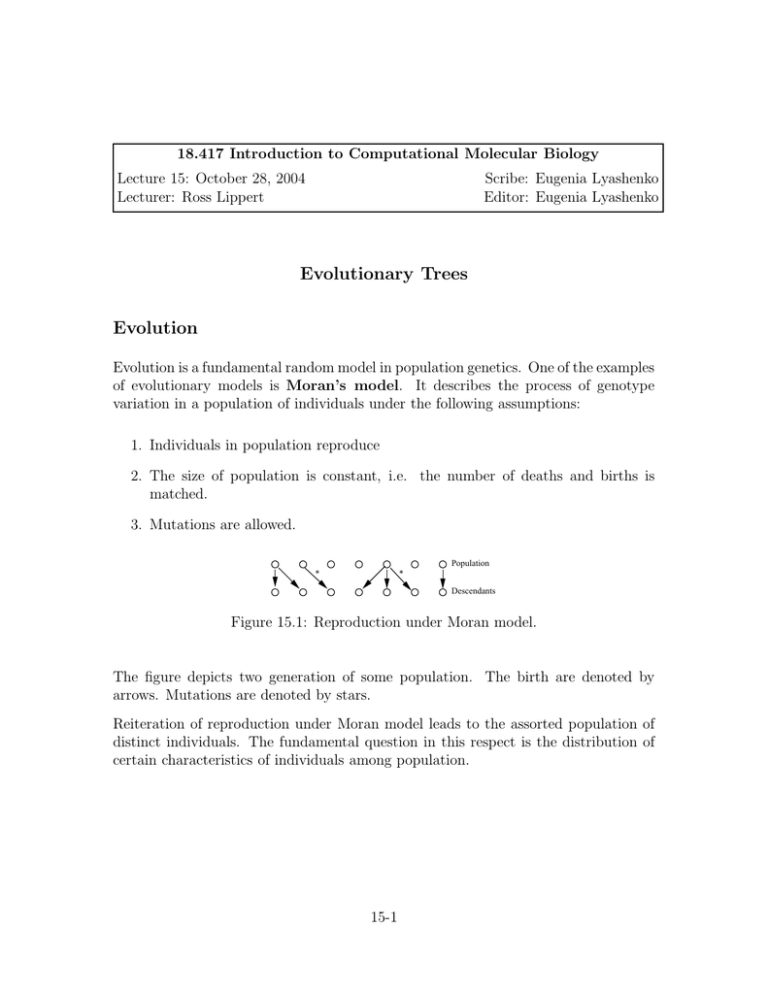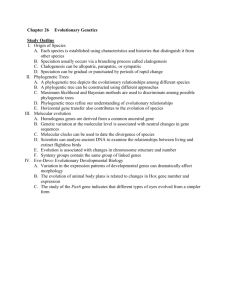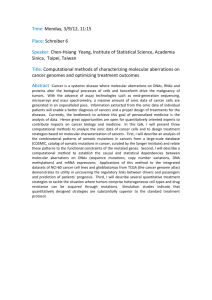Document 13587255
advertisement

18.417 Introduction to Computational Molecular Biology Lecture 15: October 28, 2004 Lecturer: Ross Lippert Scribe: Eugenia Lyashenko Editor: Eugenia Lyashenko Evolutionary Trees Evolution Evolution is a fundamental random model in population genetics. One of the examples of evolutionary models is Moran’s model. It describes the process of genotype variation in a population of individuals under the following assumptions: 1. Individuals in population reproduce 2. The size of population is constant, i.e. the number of deaths and births is matched. 3. Mutations are allowed. Population * * Descendants Figure 15.1: Reproduction under Moran model. The figure depicts two generation of some population. The birth are denoted by arrows. Mutations are denoted by stars. Reiteration of reproduction under Moran model leads to the assorted population of distinct individuals. The fundamental question in this respect is the distribution of certain characteristics of individuals among population. 15-1 15-2 Lecture 15: October 28, 2004 In the absence of mutations we can end up with the population homogeneous with respect to some trait: 1 1 1 1 1 1 1 1 1 1 Figure 15.2: No mutations. When some mutation occur, we can describe them by bit flipping. After certain amount of time we get a random distribution of a trait. 1 1 1 1 * 1 1 * 0 1 0 1 Figure 15.3: Mutations allowed. Figure 15.4: Moran model. Coalescent There are different probabilistic models that deal with above situation. One of them is the coalescent analysis. 15-3 Lecture 15: October 28, 2004 We use simplified, modified Moran model. Based on the present data it analyzes retrospectively the past events. Based on the present generation it deduces what past events might be and what are relations with ancestors. We start with the present time population and reverse the process of reproduction in Moran model. We randomly pick ancestors to the current individuals, keeping the size of population constant. We the repeat the process. This way we build a Moran Figure 15.5: Going backwards. model with some random topology. Fix a subset of individuals and select a random topology. If we go farther and farther back in time we get a tree. Figure 15.6: A tree. The coalescent has some limitations because in real world: • Parents can be mixed. • There can be more complicated modifications. • Genetic recombination can occur. Building trees Definition 1 Taxonomy is the science of classification of organisms. 15-4 Lecture 15: October 28, 2004 There are two main approaches to taxonomy. Phenetic Phenetics approach is based on the overall similarity between organisms. The main criterion for clustering species is the current similarity according to all possible traits. Cladistics Considers the various possible phylogenetic trees and chooses from among these the best possible tree. The two approaches can give different phylogenetic trees: The Phenetic & Cladistic criteria of relationship differ if evolutionary rates are unequal Lizard Crocodile Bird Birds have evolved quickly since their divergence from crocodiles Lizard Lizard Crocodile Crocodile Bird Bird Cladistic Phenetic Adapted from Figure 15.7: Phenetic vs Cladistic. Phylogenetic tree of life Bacteria Archaea Eucarya Green Filamentous bacteria Spirochetes Proteobacteria Cyanobacteria Planctomyces Bacteroides Cytophaga Gram positives Slime molds Animals Methanosarcina Fungi Entamoebae Methanobacterium Plants Halophiles Methanococcus Ciliates T. celer Flagellates Thermoproteus Trichomonads Pyrodictium Microsporidia Thermotoga Aquifex Adapted from Figure 15.8: Phylogenetic Tree of Life. Diplomonads 15-5 Lecture 15: October 28, 2004 Molecular Clock Hypothesis Introduced by Pauling and Zuckerkandl, the Molecular Clock Hypothesis states that mutations in certain regions of genome accumulate at a rate linearly proportional to time. The diagram below shows the difference in DNA between some species versus time starting from millions years ago when organisms first were found in fossils. Compare Nucleotide Substitutions 100 75 50 25 0 0 25 50 75 100 125 Millions of Years Ago Adapted from Figure 15.9: Mutations allowed. DNA of today’s organisms with ancient. This means that the amount of molecular change between two species measures how long ago they shared a common ances­ tor. Molecular differences between species are therefore used to infer phylogenetic relations. There are several ways to observe molecular clock. 1. Mutations in mitochondrial DNA (mtDNA) are used as molecular clock in many systematic studies. 2. Neutral mutation in the noncoding region of gene. 3. Mutations in ribosomal DNA (rDNA). Trees in biology Phylogenetic trees illustrate the evolutionary relationship between species. We con­ sider trees whose nodes have degree 3 each. Each node represents some species. 15-6 Lecture 15: October 28, 2004 African Non-African Common origin of European, Asian, Australian, & New World peoples 38,500 +- 1,500 yr ago 82 100 100 * 98 98 98 1 Chukchi 2 Australian 3 Australian 4 Piman 5 Italian 6 PNG Highland 7 PNG coast 8 PNG Highland 9 Georgian 10 German 11 Uzbek 12 Saam 13 Crimean Tatar 14 Dutch 15 French 16 English 17 Samoan 18 Korean 19 Chinese 20 Asian Indian 21 Chinese 22 PNG coast 23 Australian 24 Evenki 25 Buriat 26 Khirgiz 27 Warao 28 Warao 29 Siberian Inuit 30 Guarani 31 Japanese 32 Japanese 33 Mkamba 34 Ewondo 35 Bamileke 36 Lisongo 37 Yoruba 38 Yoruba 39 Mandenka 40 Effik 41 Effik 50 Mbuti 42 Ibo 43 Ibo 44 Mbenzele 45 Biaka 46 Biaka 47 Mbenzele 48 Kikuyu 49 Hausa 53 San 51Mbuti 52 San Adapted from Figure 15.10: Human mtDNA tree. External nodes correspond to present time species. Internal nodes represent their an­ cestors. External nodes called leaves represent the present time species. Each node represents an even of splitting one species from another. Ancestor Descendants Figure 15.11: Tree node Multiple splitting can also be thought of as single splitting in a short time interval. Unrooted tree is a tree without a specified root. An unrooted phylogenetic tree is a reflection of our ignorance as to where the common ancestor lies. Given a tree we can form a distance matrix whose entries are distances between pairs of leaves. Distance function on the tree should satisfy the triangle inequality d(A, B) + d(B, C) � d(A, C). Lecture 15: October 28, 2004 15-7 Distance based tree reconstruction The problem of reconstructing a tree from its distance matrix naturally arises. Given all pairwise distances in the tree we need to reconstruct the tree. Input Distance matrix from some unknown tree. Output Tree compatible with a given distance matrix. This problem is solved using additive tree reconstruction. One way to do this is to find a pair of neighboring leaves, that is leaves that have the common parent vertex. If i and j are neighboring leaves and k is their parent, then for any other leave m we have: d(i, m) + d(j, m) − d(i, j) d(k, m) = . 2 Having found neighboring pair i, j we replace them by their parent k. Then we update the distance matrix using the above formula. Hence if we had sequence of neighbors relations, we could reconstruct the tree. Determining which leaves are neighbors is however a nontrivial task. Another approach to tree reconstruction is shortening of edges. We choose a small number x, for example x = 1. If we decrease the length of each edge leaving to leaves1 by x, then all distances will decrease by 2x. Updating the distance matrix according to rule d � d − 2x, we obtain a new matrix corresponding to a tree with shorter hanging edges. If there is a triple of leaves i, j, k such that d(i, j) + d(j, k) = d(i, k) in the updated distance matrix, then leaves i, j, k lie on the single path. Hence j is attached by an edge of length 0 to the path from i to k. We can then throw out vertex j and continue. The algorithm which is based on above analysis is presented in [1][p. 364]. To discern additive distance matrix from non-additive ones we use Test for additiveness [Bunneman]. Given any four points we can rename them A, B, C, D so that: d(A, B) + d(C, D) = d(A, C) + d(B, D) � d(A, D) + d(B, C). 1 such edges are called hanging 15-8 Lecture 15: October 28, 2004 Figure 15.12: Tree node 15.0.1 Approximate additive tree reconstruction But it is a fact, that the evolutionary clock is running differently for different species and even for different regions in a protein sequence. Hence some distances matrices we obtain are not additive. Since not all distance matrices turn out to be additive, we are facing the following problem: Given a distance matrix, find the nearest additive tree? This problem is NP-complete. However, there are also several algorithms that deal with above problem. UPGMA Algorithm (Unweighted Pair Group Method with Arithmetic mean). UPMGA is a variant of Hierarchical Clustering. It assigns heights to vertices of constructed trees. The leave with the most mutations (the oldest) has the highest height. The height serves as a molecular clock in this case. Neighbor Joining Intuition behind this algorithm was mentioned above: if we identify two neighbors in a tree, join them together. Then repeat until done. We’re interested in pairs, for which not only the distance between them is smallest, but also the distance to the rest points is largest. The algorithm is following: 1. For each i define ui = � d(i, k) . n−2 k=i � 15-9 Lecture 15: October 28, 2004 2. Now take the pair i, j for which d(i, j) − ui − uj is minimal. Designate i, j to be neighbors and join them in a cluster n. 3. Recompute the distance matrix: d(n, k) = d(i, k) + d(j, k) − d(i, j) . 2 4. Repeat until finished. Character-based methods Character-based methods take as input an n × m matrix where n is the number of species and m is the number of characters. The goal is a tree whose leaves correspond to n rows. The parsimony problem, which arises in this respect, is to minimize the number of evolutionary events to put on the tree. Large Parsimony Problem2 Input An n × m matrix M describing n species, each representing by an m-character string. Output A tree T with n leaves labeled by n rows of M , and a labeling of the internal vertices of T such that the parsimony score is minimized over all possible trees and all labelings. References [1] N.C. Jones, P.A. Pevzner, Introduction to Bionformatics Algorithms, A Bradford Book, The MIT Press, Cambridge, 2004. 2 [1][p. 374]




